Reversib - Study guides, Class notes & Summaries
Looking for the best study guides, study notes and summaries about Reversib? On this page you'll find 62 study documents about Reversib.
Page 2 out of 62 results
Sort by
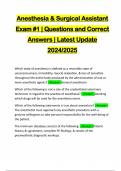
-
Anesthesia & Surgical Assistant Exam #1 | Questions and Correct Answers | Latest Update 2024/2025
- Exam (elaborations) • 7 pages • 2024
- Available in package deal
-
- $12.49
- + learn more
Anesthesia & Surgical Assistant Exam #1 | Questions and Correct Answers | Latest Update 2024/2025 Which state of anesthesia is defined as a reversible state of unconsciousness, immobility, muscle relaxation, & loss of sensation throughout the entire body produced by the administration of one or more anesthetic agents? - Answer -General anesthesia Which of the following is not a role of the credentialed veterinary technician in regard to the practice of anesthesia? - Answer -Deciding wh...
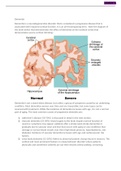
-
NR-507 Week 7 Assignment: CNS: Sensory and Motor Disorders (E-dapt Content) | aLREADY GRADED A Dementia is not a stand-alone disease, but rather, a group of symptoms caused by an underlying condition. Most dementias worsen over time and are irreversible,
- Case • 27 pages • 2022
-
- $16.39
- + learn more
NR-507 Week 7 Assignment: CNS: Sensory and Motor Disorders (E-dapt Content) | aLREADY GRADED A Dementia is not a stand-alone disease, but rather, a group of symptoms caused by an underlying condition. Most dementias worsen over time and are irreversible, but some types can be reversed with treatment. While the incidence of dementia increases with age, it is not a normal part of aging. The most common causes of progressive dementia are: 1. Alzheimer’s disease (50-70%): is discussed in detail i...
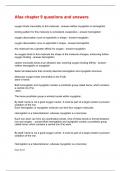
-
oxygen binds irreversibly to this molecule - answer-neither myoglobin or hemoglobin binding pattern for this molecule is considered cooperative - answer-hemoglobin oxygen dissociation curve is hyperbolic in shape - answer-myoglobin oxygen dissociation
- Exam (elaborations) • 5 pages • 2024
-
Available in package deal
-
- $9.49
- + learn more
oxygen binds irreversibly to this molecule - answer-neither myoglobin or hemoglobin binding pattern for this molecule is considered cooperative - answer-hemoglobin oxygen dissociation curve is hyperbolic in shape - answer-myoglobin oxygen dissociation curve is sigmoidal in shape - answer-hemoglobin this molecule has a greater affinity for oxygen - answer-myoglobin As oxygen binds to this molecule the shape of the molecule changes, enhancing further oxygen binding - answer-hemoglob...
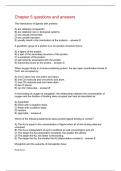
-
The interactions of ligands with proteins: A) are relatively nonspecific. B) are relatively rare in biological systems. C) are usually irreversible. D) are usually transient. E) usually result in the inactivation of the proteins. - answer-D A prost
- Exam (elaborations) • 9 pages • 2024
-
Available in package deal
-
- $11.49
- + learn more
The interactions of ligands with proteins: A) are relatively nonspecific. B) are relatively rare in biological systems. C) are usually irreversible. D) are usually transient. E) usually result in the inactivation of the proteins. - answer-D A prosthetic group of a protein is a non-protein structure that is: A) a ligand of the protein. B) a part of the secondary structure of the protein. C) a substrate of the protein. D) permanently associated with the protein. E) trans...
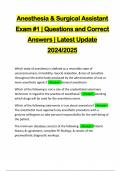
-
Anesthesia & Surgical Assistant Exam #1 | Questions and Correct Answers | Latest Update 2024/2025
- Exam (elaborations) • 7 pages • 2024
- Available in package deal
-
- $10.99
- + learn more
Anesthesia & Surgical Assistant Exam #1 | Questions and Correct Answers | Latest Update 2024/2025 Which state of anesthesia is defined as a reversible state of unconsciousness, immobility, muscle relaxation, & loss of sensation throughout the entire body produced by the administration of one or more anesthetic agents? - Answer -General anesthesia Which of the following is not a role of the credentialed veterinary technician in regard to the practice of anesthesia? - Answer -Deciding wh...
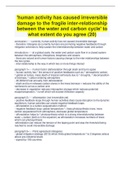
-
human activity has caused irreversible damage to the fragile inter-relationship between the water and carbon cycle' to what extent do you agree (20)
- Exam (elaborations) • 2 pages • 2023
-
- $12.49
- + learn more
human activity has caused irreversible damage to the fragile inter-relationship between the water and carbon cycle' to what extent do you agree (20)
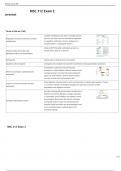
-
BISC 312 Exam 2 Terms in this set (163) Regulation of enzyme activity by covalent modification covalent modifications are often reversible and are done by enzymes which are themselves subjected to regulation. Extremely common strategy (ex. phosphor
- Exam (elaborations) • 10 pages • 2024
- Available in package deal
-
- $8.99
- + learn more
BISC 312 Exam 2 Terms in this set (163) Regulation of enzyme activity by covalent modification covalent modifications are often reversible and are done by enzymes which are themselves subjected to regulation. Extremely common strategy (ex. phosphorylation or dephosphorylation) phosphorylation by kinases and dephosphorylation by phosphatases utilize an ATP that adds a phosphate group to a specific amino acid on an enzyme zymogems proenzymes or inactive forms of enzymes regulati...
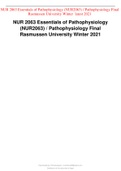
-
NUR 2063 Essentials of Pathophysiology Final Exam Review Study Guide 1. Cirrhosis (end stage liver disease) - irreversible end-stage of many different hepatic injuries Alcoholism, acute hepatitis, toxic hepatitis (taking too much Tylenol), and liver is fi
- Exam (elaborations) • 54 pages • 2022
- Available in package deal
-
- $21.99
- + learn more
NUR 2063 Essentials of Pathophysiology Final Exam Review Study Guide 1. Cirrhosis (end stage liver disease) - irreversible end-stage of many different hepatic injuries Alcoholism, acute hepatitis, toxic hepatitis (taking too much Tylenol), and liver is fibrotic and scarred 2. What is another name for cirrhosis? - End stage lover disease 3. What happens to albumin production with liver failure? - Albumin production decreases during liver failure 4. What role does albumin play in the blood? - Albu...
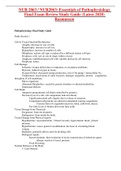
-
NUR 2063 Essentials of Pathophysiology Final Exam Review Study Guide 1. Cirrhosis (end stage liver disease) - irreversible end-stage of many different hepatic injuries Alcoholism, acute hepatitis, toxic hepatitis (taking too much Tylenol), and liver is fi
- Package deal • 3 items • 2022
-
- $40.49
- + learn more
NUR 2063 Essentials of Pathophysiology Final Exam Review Study Guide 1. Cirrhosis (end stage liver disease) - irreversible end-stage of many different hepatic injuries Alcoholism, acute hepatitis, toxic hepatitis (taking too much Tylenol), and liver is fibrotic and scarred 2. What is another name for cirrhosis? - End stage lover disease 3. What hap
Exergy and Irreversibility handwritten notes.

How did he do that? By selling his study resources on Stuvia. Try it yourself! Discover all about earning on Stuvia



